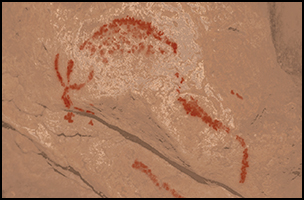Crossref Citations
This article has been cited by the following publications. This list is generated based on data provided by
Crossref.
Robert, Éric
Paillet, Patrick
and
Petrognani, Stéphane
2018.
L’art préhistorique, une archéologie.
Les Nouvelles de l'archéologie,
p.
4.
Garate, Diego
Rivero, Olivia
and
Ontañón, Roberto
2019.
New insights into the European Palaeolithic Art: Symbolic interactions in the Bay of Biscay.
Journal of Archaeological Science: Reports,
Vol. 27,
Issue. ,
p.
101973.
Ruiz-Redondo, Aitor
Yanovskaya, Katherin
and
Zhitenev, Vladislav S.
2020.
The Easternmost European Palaeolithic Artists: Iconography and Graphic Features at Kapova Cave (Southern Urals, Russia).
Journal of Paleolithic Archaeology,
Vol. 3,
Issue. 4,
p.
967.
Bednarik, Robert G.
2020.
First Pleistocene rock art found in central Europe.
L'Anthropologie,
Vol. 124,
Issue. 3,
p.
102778.
Sigari, Dario
2020.
REVIEW OF THE ANIMAL FIGURES IN THE PALAEOLITHIC ROCK ART OF THE ROMITO SHELTER. NEW DISCOVERIES, NEW DATA AND NEW PERSPECTIVES.
Oxford Journal of Archaeology,
Vol. 39,
Issue. 4,
p.
344.
Ortega-Martínez, Ana Isabel
Martín-Merino, Miguel Ángel
and
García-Diez, Marcos
2020.
Palaeolithic creation and later visits of symbolic spaces: radiocarbon AMS dating and cave art in the Sala de las Pinturas in Ojo Guareña (Burgos, Spain).
Archaeological and Anthropological Sciences,
Vol. 12,
Issue. 10,
Sakamoto, Takashi
Pettitt, Paul
and
Ontañon-Peredo, Roberto
2020.
Upper Palaeolithic Installation Art: Topography, Distortion, Animation and Participation in the Production and Experience of Cantabrian Cave Art.
Cambridge Archaeological Journal,
Vol. 30,
Issue. 4,
p.
665.
Moro Abadía, Oscar
and
González Morales, Manuel R.
2020.
Art in the Making: Recent Developments in the Study of Pleistocene and Holocene Images.
Journal of Archaeological Method and Theory,
Vol. 27,
Issue. 3,
p.
439.
Ruiz-Redondo, Aitor
Garate, Diego
González-Morales, Manuel R.
Janković, Ivor
Jaubert, Jacques
Karavanić, Ivor
Komšo, Darko
Kuhn, Steven L.
Mihailović, Dušan
Moro Abadía, Óscar
Vander Linden, Marc
and
Vukosavljević, Nikola
2020.
Beyond the Bounds of Western Europe: Paleolithic Art in the Balkan Peninsula.
Journal of World Prehistory,
Vol. 33,
Issue. 4,
p.
425.
Pitarch Martí, Africa
Zilhão, João
d’Errico, Francesco
Cantalejo-Duarte, Pedro
Domínguez-Bella, Salvador
Fullola, Josep M.
Weniger, Gerd C.
and
Ramos-Muñoz, José
2021.
The symbolic role of the underground world among Middle Paleolithic Neanderthals.
Proceedings of the National Academy of Sciences,
Vol. 118,
Issue. 33,
Peresani, Marco
Monegato, Giovanni
Ravazzi, Cesare
Bertola, Stefano
Margaritora, Davide
Breda, Marzia
Fontana, Alessandro
Fontana, Federica
Janković, Ivor
Karavanić, Ivor
Komšo, Darko
Mozzi, Paolo
Pini, Roberta
Furlanetto, Giulia
Maria De Amicis, Mattia Giovanni
Perhoč, Zlatko
Posth, Cosimo
Ronchi, Livio
Rossato, Sandro
Vukosavljević, Nikola
and
Zerboni, Andrea
2021.
Hunter-gatherers across the great Adriatic-Po region during the Last Glacial Maximum: Environmental and cultural dynamics.
Quaternary International,
Vol. 581-582,
Issue. ,
p.
128.
Sigari, Dario
Mazzini, Ilaria
Conti, Jacopo
Forti, Luca
Lembo, Giuseppe
Mecozzi, Beniamino
Muttillo, Brunella
and
Sardella, Raffaele
2021.
Birds and bovids: new parietal engravings at the Romanelli Cave, Apulia.
Antiquity,
Vol. 95,
Issue. 384,
p.
1387.
Guy, Emmanuel
2021.
Réflexion sur la fonction sociale des « écoles artistiques ».
Paléo,
p.
190.
Ruiz-Redondo, Aitor
Vukosavljević, Nikola
Tomasso, Antonin
Peresani, Marco
Davies, William
and
Vander Linden, Marc
2022.
Mid and Late Upper Palaeolithic in the Adriatic Basin: Chronology, transitions and human adaptations to a changing landscape.
Quaternary Science Reviews,
Vol. 276,
Issue. ,
p.
107319.
Farbstein, Rebecca
2023.
The Prehistoric Hunter-Gatherers of South-Eastern Europe.
Farbstein, Rebecca
2023.
The Prehistoric Hunter-Gatherers of South-Eastern Europe.
p.
288.
Ruiz-Redondo, Aitor
and
Davies, William
2023.
The Prehistoric Hunter-Gatherers of South-Eastern Europe.
Langlais, Mathieu
Ducasse, Sylvain
Delvigne, Vincent
Laroulandie, Véronique
Mallye, Jean-Baptiste
Pétillon, Jean-Marc
Boudadi-Maligne, Myriam
and
Pironneau, Camille
2023.
Un autre visage de la grotte ornée de Gabillou (Sourzac, Dordogne, France). Étude du mobilier lithique et osseux des fouilles de J. Gaussen.
Paléo,
Vol. 33,
Issue. ,
p.
56.
Vukosavljević, Nikola
2023.
The Prehistoric Hunter-Gatherers of South-Eastern Europe.
p.
252.
Vukosavljević, Nikola
2023.
The Prehistoric Hunter-Gatherers of South-Eastern Europe.



